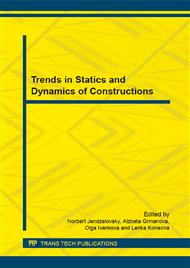p.107
p.112
p.118
p.126
p.133
p.139
p.145
p.153
p.161
Numerical Analysis of the Influence of the Parameter of Ductility of Reinforcing Steel on the Behaviour of Narrow Three-Span Reinforced Concrete Slabs from the Point of View of Experimental Investigations
Abstract:
In the time of exploitation of building structures frequently situations do occur, in which due to failures they are exposed to much higher loads than originally predicted. The subject matter of the performed investigations and a numerical analysis are models of four narrow reinforced concrete slabs with the dimensions 7140×500×190 mm. The paper presents the results of the numerical analysis, the aim of which was to reflect and to provide detailed information about phenomena occurring in the course of laboratory tests. Numerical models were constructed according to the system ANSYS, applying volumetric elements SOLID65 and bars LINK8. In order to determine the relation σ-ε of steel an isotropic model of strengthening in the system ANSYS was used, constructed by Misses. The behaviour of concrete was represented by the material model Concrete. The parameters applied in the material models had been obtained in laboratory tests of the material. The paper quotes the results of calculations compared with the results obtained in laboratory tests.
Info:
Periodical:
Pages:
133-138
Citation:
Online since:
June 2015
Authors:
Price:
Сopyright:
© 2015 Trans Tech Publications Ltd. All Rights Reserved
Share:
Citation:


